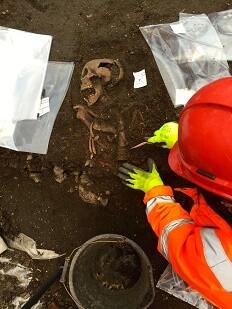At the Bedlam Burial Ground
Nick Richardson
Dead bodies are being evicted from East London to make way for the new Crossrail station at Liverpool Street. Crossrail is gentrifying the soil. Last week archaeologists began digging up skeletons from what used to be the Bedlam, or Bethlehem, burial ground. The cemetery took its name from the lunatic asylum, which was close by, and some of the people buried there were former inmates. But it was mostly used, between 1569 and 1738, by East London parishes as an overflow cemetery for ill-favoured corpses, an underground slum for the dead.
The people buried there include John Lambe, stoned to death by a mob in 1628. He was a ‘cunning man’ and a personal adviser to George Villiers, Duke of Buckingham. He could make people impotent without laying a finger on them, allegedly, and once produced out of thin air both a miniature tree and a homunculus with an axe, who chopped the tree down. He also made a whirlwind whip along the Thames unearthing corpses in a graveyard. In 1627 he was accused of raping a young girl, but used his contacts to dodge justice, until the mob stepped in and did for him.
John Lilburne, another of the cemetery’s inhabitants, was almost as much of a goody goody as Lambe was the opposite: a Leveller and campaigner for ‘freeborn rights’ who, despite his many brushes with the judiciary and a stint in the Tower for treason, died free in 1657.
He was buried close to Nicholas Culpeper, who was both a witch and a political activist. He spent years campaigning for cheap, plant-based medicine for all, and against mainstream physicians, who were expensive and useless. But he sabotaged his own PR by dying of tuberculosis in 1654 at the age of 37.
Most of the 3000 people being exhumed died in the 1665 Great Plague. Their bodies are going to be sent to the Museum of Archaeology, where they’ll have their teeth examined for traces of Yersinia pestis, the bacteria behind the buboes. The hope is that some light will be thrown on how the bacteria evolved from its medieval form, and how it might continue to change. Last year a man in China died after catching bubonic plague from a dead marmot. He was quarantined, and the disease contained, but the incident was a nasty reminder that the plague hasn’t disappeared. It would be magic of the best kind if people killed off by it 350 years ago helped to kill it off now for good.

Comments